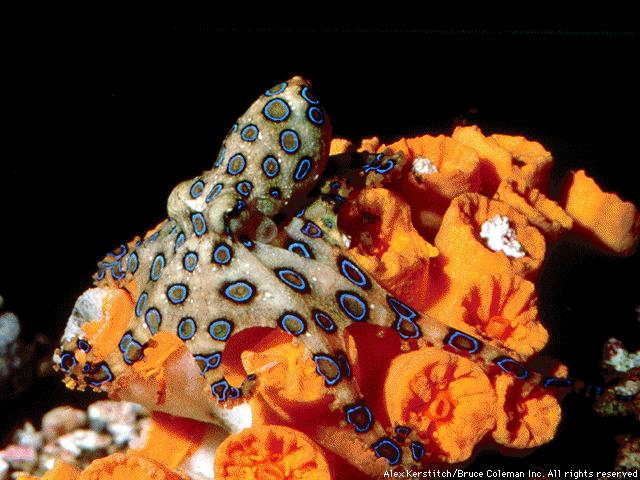
Above is the incredible blue-ringed octopuse.
| Class Cephalopoda | ||||||||||||||
| It is surprising to many that cephalopods such as octopus and squid should belong to the phylum Mollusca. However, biologists have discovered that the embryological development, the structural aspects of the mantle and the presence of the classical radular teeth leave no doubt that the Cephalopods are part of the molluscan clan. | ||||||||||||||
| This is the most highly developed class of the phylum Mollusca, comprising such well-known and even infamous creatures as the octopus, the cuttlefish and the squid. The term cephalopod is derived from the Latin words cepha, meaning head or brain, and poda, meaning foot. The cephalopods are formed of a large head, containing what can be compared to a brain, from which extend many arms. In reality the brain is made up of thousands of ganglion, groupings of nerves, closely connected and is protected by a cartilagenous brain case. Their ?feet? are obviously their tentacles which they use for attacking, catching and eating their prey. This class is formed of predators that eat other mollusks as well a variety of oceanic organisms. | ||||||||||||||
| In the exception of the chambered nautilus (N. pompilus), cephalopods have two gills, two kidneys and three hearts; the nautilus has four gills and four kidneys. Cephalopod blood contains hemocyanin and is bleu when oxygenated compared to human blood which contains hemoglobin. Cephalopods have also evolved a unique mode of transportation. By a siphon-jet system, they propel through the water. | ||||||||||||||
| Cephalopods have evolved an incredibly sophisticated nervous system allowing most to change their color and also giving them great speed, strength and agility. Most cephalopods have an inc sac underneath their head which they use to escape from predators or to disorient prey by injecting ink into the water. | ||||||||||||||
| The nautilus is the only family of cephalopod that still has a shell. The argonaut, often called paper nautilus, is often referred to as having a shell. In fact the female lays her eggs in a special egg case made of a special paper-thin material closely resembling the shells of the nautiluses. Nautiluses usually inhabit the depths of the oceans but they can control their buoancy by increasing or decreasing the amount of air in the various chambers of their shell. The nautilus itself inhabits the largest of about twelve chambers. The other chambers are used purely to control buoancy. The nautilus is the last of a vanishing line of cephalopods, once abundant approximately four-hundred million years ago. Today they are limited to three or four species. | ||||||||||||||
 Above is the incredible blue-ringed octopuse. |
||||||||||||||
| Home | ||||||||||||||
| Intro | ||||||||||||||
| Gastropopa | ||||||||||||||
| Pelecypoda | ||||||||||||||
| Cephalopoda | ||||||||||||||
| Scaphopoda | ||||||||||||||
| Amphineura | ||||||||||||||
| Monoplacophora | ||||||||||||||
| Bibliography | ||||||||||||||